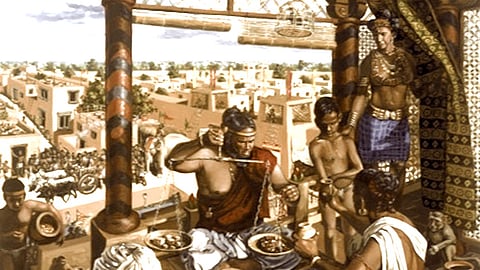- Commentary
- History Vignettes
- Notes on Culture
- Dispatches
- Podcasts
- Indian LanguagesIndian Languages
- Support

THE PREVIOUS EPISODE gave a list of twenty-seven professional or corporate guilds in ancient India.
At a high level, there was a clear difference between trading and merchant guilds on the one hand and guilds of artisans on the other.
To understand this in a clearer fashion, in that era, typically, hereditary families following certain branches of trade formed themselves into exclusive corporations with a Jyeshtaka or Jyeshta as their head.
However, the artisans were rather strict in this regard. The son of an artisan had to compulsorily undergo an apprenticeship under his father for several years starting from childhood. Quite obviously, skill, talent and expertise in a particular craft or profession was honed generationally. It rarely passed out of the family.
In fact, artisan guilds or corporations were also a powerful force to reckon with in both politics and society. An eminent proof of this fact emerges when we observe town planning methods in ancient and medieval India. Entire townships, villages, streets, and quarters were named after specific artisans. Even until recently, it was common to find streets with such names. In Karnataka, every city and town had a Ganigara-Keri (quarters of oil millers), Kumbarara-beedi (carpenters’ street) and so on. We once again notice how this even facet indicates the Hindu civilizational continuity viewed from the perspective of our commercial history. For example, in ancient India, the word Kammara-Gaamo meant a village of ironsmiths. The Kannada word Kammara even today means an ironsmith.
An intriguing fact is that these guilds were also highly mobile and could move or migrate to long distances at astonishing speeds. We have an example of a guild comprising one thousand families of carpenters near Varanasi who left the town during a troubled period and settled in a faraway island.
Next, we’ll look at some major aspects of how these artisan guilds were organized, broadly around three factors:
1. Heredity of profession
2. Localisation of different branches or specialisations within the profession
3. The office of the Jyeshta, the supreme head of the guild
The Jyeshta was akin to an Alderman in the western parlance (who typically served on the city council or county board, etc). In ancient India, the Jyestha sometimes performed the role of a Governor or local magistrate or head of a city council and generally held a powerful position in the state’s administrative apparatus. Some Jyeshtas were the favourites of the King as well.
Thus, owing to this kind of power and prestige, quarrels and fights erupted among various Jyeshtas on several occasions. It is said that Buddha himself had to step in to settle their disputes in his own lifetime. Over time, when the frequency of such disputes increased, it led to the establishment of a Special Tribunal. The first recorded such Tribunal was the Office of the Supreme Head of Guilds in the ancient Kingdom of Kashi. The Bhāṇḍāgārika or royal treasurer (akin to the RBI Governor in contemporary parlance) himself was appointed to this post. He had full judicial powers over all the Jyeshtas in the kingdom.
In fact, the more we dig into these primary sources, the more gold we get. But all these sources clearly prove the same historical point: the centrality and inseparability of corporations in ancient India’s political, social and cultural life.
Within each corporation, rules and regulations and laws were uniformly and strictly binding on all members from the chief to the office-bearer occupying the lowest rung.
Guilds were also entitled to arbitrate and adjudicate even in certain personal matters concerning its members and their wives. Not infrequently, the wives were formally ordained to manage several key areas of the corporation’s activities. In a highly interesting episode in the Vinayapitaka, we learn of how some wives of the guild members were even permitted to become Sanyasinis.
And now, we can consider some aspects of ancient India’s commercial and corporate activity in the epoch-making and epoch-altering period of Kautilya.
In this period, we notice a gradual but systematic crystallization in the realms of economics, commerce, trade and corporate activity, broadly speaking. These areas were also arranged in a profound manner, in the sense of Na Bhuto na bhavishyati.
I’ll touch upon just some of the major features in this connection.
In the Kautilyan and broadly speaking, the Mauryan Empire, taxes remitted by guilds and corporations were one of the most important sources of revenue. The Superintendent of Accounts had to enter the following information in registers and account ledgers prescribed by the Government:
1. A detailed history of the customs of each guild or corporation
2. Specific details of the customs themselves
3. A list of each profession, trade, craft, industry, etc., in the Empire
4. Details of the transactions of each guild or corporation
A well-defined process was established whereby guilds or corporations could elect three ministers who enjoyed their confidence. These ministers would be their quasi representatives within the Government machinery looking after their interests and pleading their case. As a mark of their confidence in the ministers, guild or corporate heads voluntarily made refundable deposits to the royal treasury. A measure of the mutual trust that existed between these corporate bodies and the government was the fact that they rarely asked for a refund, except in extreme conditions such as famine, etc.
This system turned out to be phenomenally enduring and was pan-Indian in scope. It was maintained almost intact even during the reign of the Nayakas in southern India, after the fall of the Vijayanagara Empire.
To be continued
The Dharma Dispatch is now available on Telegram! For original and insightful narratives on Indian Culture and History, subscribe to us on Telegram.
